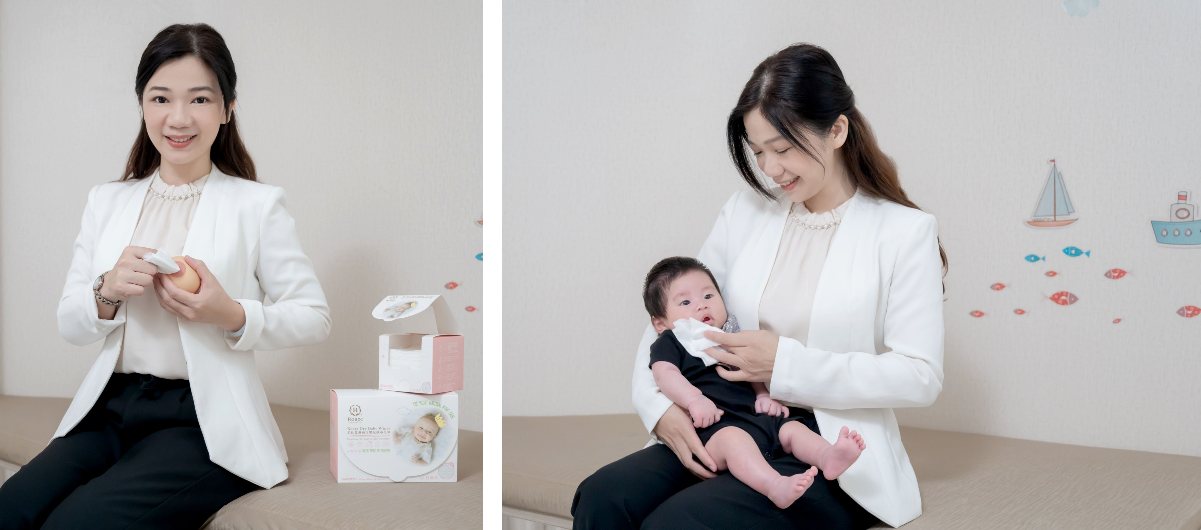
Interview and Expert Consultation (from left to right): International Board Certified Lactation Consultant (IBCLC) – Ya-Han Lin (Ms. Mimi), Dentist – Dr. Pin-Han Chen, and Head Nurse Chun-Tzu Wang from Fu-Yu Postpartum Care Center
Life with a newborn often feels like organized chaos. For new parents, emotions can rise and fall with the baby’s daily output—how much they eat, how often they pee. With crying as their only form of communication, how can parents accurately respond to their needs? The answer is often simple: proper hygiene.
Common infant issues such as oral thrush, atopic dermatitis, and diaper rash can frequently be improved with gentle and effective cleansing habits.
Nurse’s Advice: Rinse with Water to Prevent Diaper Rash
A newborn’s skin barrier is still underdeveloped, with a stratum corneum only about one-third the thickness of an adult’s. Combined with immature sweat glands and poor temperature regulation, their skin is prone to oiliness and heat rash. Using soap-based cleansers or chemically treated wet wipes can cause contact dermatitis, making skin even more sensitive and increasing the risk of conditions like atopic dermatitis or diaper rash.
Chun-Tzu Wang, Head Nurse at Fu-Yu Postpartum Care Center, emphasizes that newborn skin is naturally protected by vernix caseosa. Simply rinsing with clean water and keeping the diaper area dry significantly lowers the risk of diaper rash.
She recommends using the Roaze Dual-Use Cotton Gauze Towels—made from 100% medical-grade, additive-free spunlace fabric. They are soft, highly absorbent, and easy to wring with one hand during water cleansing, making them perfect for reaching skin folds.
Before putting on a diaper, always make sure the skin is fully dry. Healthy skin can be protected with a layer of petroleum jelly to shield against urea, while zinc oxide creams are effective if redness or irritation is already present.
For many new parents, bath time can be the most stressful part of the day—but it’s also an important bonding ritual before bedtime. How can you make baby baths smooth and stress-free?
Head Nurse Wang suggests a top-to-bottom routine: begin with the face, then head, torso, and limbs. Gently support the baby’s neck and use a dual-use cotton gauze towel to clean the eyes, ears, nose, and mouth. Talk to your baby throughout—this not only helps soothe them but also stimulates tactile awareness and a sense of facial orientation.

Product featured and recommended by Fu-Yu Postpartum Care Center: Roaze Baby oral cleaning wipes (180 pcs)
Dentist’s Reminder: Never Use Bath Water to Clean Baby’s Mouth
Dr. Pin-Han Chen, a dental care expert, cautions against using bath water to clean a baby’s mouth, as it may contain bacteria or bodily contaminants. Instead, he advises using drinking water and a gauze wipe to gently clean the baby’s gums and oral tissues between feedings. Ideally, oral hygiene should be practiced twice a day—between morning feeds and after the final bedtime bottle—to prevent milk residue buildup, which can lead to oral thrush (candida infection), feeding aversion, or even gastrointestinal issues.
Lactation Expert’s Tip: Clean Nipples for a Healthy Start to Breastfeeding
Breastfeeding struggles, such as clogged ducts, are often caused by poor latching techniques. According to Ya-Han Lin, an International Board Certified Lactation Consultant (IBCLC) known as “Ms. Mimi,” proper breastfeeding should be gentle and pain-free.
Shape your nipple to fit your baby’s open mouth and align it with their nose to trigger the rooting reflex. When the baby opens wide, bring them close so they can latch deeply, taking in both the nipple and areola. The baby’s chin should touch the breast, lower lip should flare out, and their cheeks should appear rounded and full while swallowing—this ensures efficient milk transfer.
If you notice cracked or scabbed nipples, check for residue buildup, blisters, or signs of damage. Before each nursing session, use a dual-use gauze towel dampened with warm water to gently wipe the nipple area. During showers, moms can also clean the area with baby-safe body wash and gauze towels, making sure to reach hidden creases. Aim for at least one thorough cleaning per day, and follow with a thin layer of expressed milk to moisturize and speed healing.

100% Medical-Grade Spunlace Cotton | Made in Taiwan
Roaze Dry Bay Wipes – Comfort Series (160 pcs)